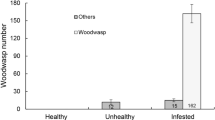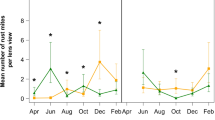Abstract
Although Eriophyoidea is one of the most important phytophagous mite taxa owing to its negative impact on plants, reports on associations between occurrences of eriophyoid species are scarce. The aim of this paper is to test the hypothesis that the occurrence of one species is correlated with the occurrence of another in some predictive manner. Analyses are carried out for two popular coniferous trees in Poland, i.e., Norway spruce (Picea abies) and Scots pine (Pinus sylvestris). Observations were made in four locations in Poland, from three age groups of trees, namely adult trees (thirty 15-cm shoot samples from each of ten trees), young trees (ten 15-cm shoot samples from each of ten trees) and seedlings (100 whole-seedling samples). The associations were estimated by Yule’s V index. Among four eriophyoid species observed on Scots pine, and the same number of species on Norway spruce, in general no association pattern was observed. It means that their occurrence is independent. The most likely explanation for the absence of co-occurrence is the abundance of microhabitats on coniferous trees for eriophyoid mites, combined with the low mite density on these plant hosts.
Similar content being viewed by others
References
Amrine JW Jr, Manson DCM (1996) Preparation, mounting and descriptive study of eriophyoid mites. In: Lindquist EE, Sabelis MW, Bruin J (eds) Eriophyoid mites: their biology, natural enemies and control (World Crop Pests). Elsevier, Amsterdam, pp 383–396
Bagnyuk IG, Shevtchenko VG (1982) Novyj vid četyrehnogyh kleščej roda Trisetacus Keifer (Acarina, Tetrapodili) s eli obyknoviennoj Picea abies (L.) Krast. (A new species of mite of the genus Trisetacus Keifer (Acarina, Tetrapodili) on spruce, Picea abies (L.) Karst.). Entomol Obozr 61(1):195–200
Boczek J (1961) Badania nad roztoczami z rodziny Eriophyidae (Szpecielowate) w Polsce I. Prace Naukowe Instytutu Ochrony Roślin 3(2):5–85
Boczek J (1969) Studies on mites (Acarina) living on plants in Poland XI. Bull Acad Pol Sci 17(6):393–398
Boczek J, Shevchenko VG (1996) Ancient associations: eriophyoid mites and gymnosperms. In: Lindquist EE, Sabelis MW, Bruin J (eds) Eriophyoid mites: their biology, natural enemies and control (World Crop Pests). Elsevier, Amsterdam, pp 217–225
Croft BA, Hoying SA (1977) Competitive displacement of Panonychus ulmi (Acarina:Tetranychidae) by Aculus schlechtendali (Acarina:Eriophyidae) in apple orchards. Can Entomol 109:1025–1034
Dunley JE, Croft BA (1996) Eriophyoids as competitors of other phytophagus mites. In: Lindquist EE, Sabelis MW, Bruin J (eds) Eriophyoid mites: their biology, natural enemies and control (World Crop Pests). Elsevier, Amsterdam, pp 751–755
Krantz GW (1979) The role of Phytocoptella avellanae (Nal.) and Cecidophyopsis vermiformis (Nal.) (Eriophyoidea) in big bud of filbert. In: Piffl E (ed) Proceedings of 4th International Congress of Acarology, Académiai Kiadó, Budapest, pp 201–208
Lewandowski M (2006) A new eriophyoid mite species (Acari: Eriophyoidea) on Picea abies (Pinaceae). Zootaxa 1304:61–68
Lewandowski M, Kozak M (2008) Distribution of eriophyoid mites (Acari: Eriophyoidea) on coniferous trees. Exp Appl Acarol 44:89–99
Lindquist EE, Sabelis MW, Bruin J (1996) Eriophyoid mites: their biology, natural enemies and control (World Crop Pests). Elsevier, Amsterdam
Löyttyniemi K (1975) Mass outbreaks of Epitrimerus pungiscus Keifer (Acarina, Eriophyidae) on Norway spruce, Picea abies (L.) Karst. Ann Ent Fenn 41:13–15
Muraleedharan N, Radhakrishnan B, Devadas V (1988) Vertical distribution of three species of eriophyid mites on tea in South India. Exp Appl Acarol 4:359–364
Nielsen BO (1978) Food resource portioning in the beech leaf-feeding guild. Ecol Entomol 3:193–201
Nuzzaci G, de Lillo E (1996) Perspectives on eriophyoid mite research. Entomologica, Bari 30:73–91
Oldfield GN, Proeseler G (1996) Eriophyoid mites as vectors of plant pathogens. In: Lindquist EE, Sabelis MW, Bruin J (eds) Eriophyoid mites: their biology, natural enemies and control (World Crop Pests). Elsevier Science B.V., Amsterdam, pp 259–275
Sabelis MW, Bruin J (1996) Evolutionary ecology: life history patterns, food plant choice and dispersal. In: Lindquist EE, Sabelis MW, Bruin J (eds) Eriophyoid mites: their biology, natural enemies and control (World Crop Pests). Elsevier, Amsterdam, pp 329–366
Sabelis MW, van Rijn PCJ (1996) Eriophyoid mites as alternative prey. In: Lindquist EE, Sabelis MW, Bruin J (eds) Eriophyoid mites: their biology, natural enemies and control (World Crop Pests). Elsevier, Amsterdam, pp 757–764
Schluter D (1984) A variance test for detecting species associations, with some example applications. Ecology 65:998–1005
Skoracka A, Lewandowski M, Boczek J (2005) Catalogue of eriophyoid mites of Poland. Catalogus faunae Poloniae (N.S.), No. 1. Natura optima dux foundation, museum and institute of zoology. Polish Academy of Sciences, Warszawa, p 199
Slone DH, Croft BA (2001) Species association among predaceous and phytophagous apple mites (Acari: Eriophyidae, Phytoseiidae, Stigmaeidae, Tetranychidae). Exp Appl Acarol 25:109–126
Soika G, Łabanowski GS (1999) Eriophyid mites (Acari: Eriophyoidea) on ornamental plants in Poland. Pinaceae family: descriptions of two new species. Bull Pol Acad Sci Biol Sci 47(1):43–52
Webster R (2007) Analysis of variance, inference, multiple comparisons and sampling effects in soil research. Eur J Soil Sci 58:74–82
Westphal E, Manson DCM (1996) Feeding effect on host plants: gall formation and other distortions. In: Lindquist EE, Sabelis MW, Bruin J (eds) Eriophyoid mites: their biology, natural enemies and control (World Crop Pests). Elsevier, Amsterdam, pp 661–671
Acknowledgments
We wish to thank Professor Danuta Kropczyńska-Linkiewicz (WULS-SGGW, Warsaw, Poland) for her valuable suggestions on the manuscript, and Jan Bruin for his valuable comments on and edits of the manuscript. This study was partly supported financially by the Polish Ministry of Science and Higher Education, grant no. N309 003 32/0554.
Author information
Authors and Affiliations
Corresponding author
Rights and permissions
About this article
Cite this article
Kozak, M., Lewandowski, M. Eriophyoid mites (Acari: Eriophyoidea) on coniferous trees: is the occurrence of one species associated with the other?. Exp Appl Acarol 50, 115–122 (2010). https://doi.org/10.1007/s10493-009-9291-x
Received:
Accepted:
Published:
Issue Date:
DOI: https://doi.org/10.1007/s10493-009-9291-x




